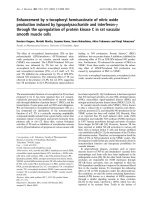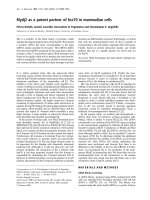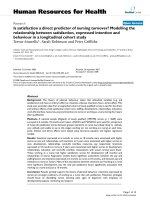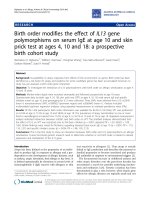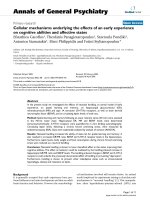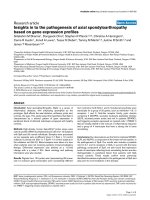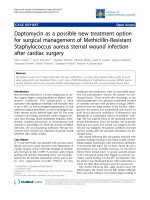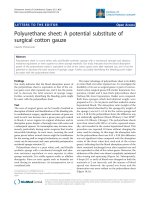Báo cáo y học: "Ischemia as a possible effect of increased intraabdominal pressure on central nervous system cytokines, lactate and perfusion pressures" ppsx
Bạn đang xem bản rút gọn của tài liệu. Xem và tải ngay bản đầy đủ của tài liệu tại đây (708.86 KB, 10 trang )
RESEARC H Open Access
Ischemia as a possible effect of increased intra-
abdominal pressure on central nervous system
cytokines, lactate and perfusion pressures
Athanasios Marinis
1*
, Eriphili Argyra
2
, Pavlos Lykoudis
1
, Paraskevas Brestas
1
, Kassiani Theodoraki
2
,
Georgios Polymeneas
1
, Efstathios Boviatsis
3
, Dionysios Voros
1
Abstract
Introduction: The aims of our study were to evaluate the impact of increased intra-abdominal pressure (IAP) on
central nervous system (CNS) cytokines (Interleukin 6 and tumor necrosis factor), lactate and perfusion pressures,
testing the hypothesis that intra-abdominal hypertension (IAH) may possibly lead to CNS ischemia.
Methods: Fifteen pigs were studied. Helium pneumoperitoneum was established and IAP was increased initially at
20 mmHg and subsequently at 45 mmHg, which was finally followed by abdominal desufflation. Interleukin 6 (IL-6),
tumor necrosis factor alpha (TNFa) and lactate were measured in the cerebrospinal fluid (CSF) and intracranial (ICP),
intraspinal (ISP), cerebral perfusion (CPP) and spinal perfusion (SPP) pressures recorded.
Results: Increased IAP (20 mmHg) was followed by a statistically significant increase in IL-6 (p = 0.028), lactate
(p = 0.017), ICP (p < 0.001) and ISP (p = 0.001) and a significant decrease in CPP (p = 0.013) and SPP (p = 0.002).
However, further increase of IAP (45 mmHg) was accompanied by an increase in mean arterial pressure due to
compensatory tachycardia, followed by an increase in CPP and SPP and a decrease of cytokines and lactate.
Conclusions: IAH resulted in a decrease of CPP and SPP lower than 60 mmHg and an increase of all ischemic
mediators, indicating CNS ischemia; on the other hand, restoration of perfusion pressures above this threshold
decreased all ischemic indicators, irrespective of the level of IAH.
Introduction
Intra-abdominal hypertension (IAH) and abdominal
compartment syndrome (ACS) are two clinical entities
constituting a continuum of pathophysiologic sequelae
ranging from mild elevations of intra-abdominal pres-
sure (IAP) to the devastating effects of organ hypoperfu-
sion and, uneventfully, to death. Although effects of
increased intra-abdominal pressure (IAP) on various
organs and systems have been reported over 150 years
ago, pathophysiologic implications have been rediscov-
ered and definitions and recommendations developed
the last few years [1-7].
Currently, the pathophysiological interaction of the
abdominal compartment with other compartments
(thoracic, cranial a nd extremities) has been extensively
studied, comprising the polycompartment syndrome, a
term coined by Malbrain M et al [5,8]. This holistic
view emphasizes the relationships developing directly
and indirectly between these body compartments, with
potential therapeutic implications in everyday practice.
An interesting part of this concept is the relationship
of IAH and the central nervous system (CNS) [9]. Sev-
eral experimental and clinical studies have described the
development o f intracranial hypertension (ICP) and the
decrease in cerebral perfusion pressure (CPP) during
IAH [ 10-21]. These findings are based upon the modi-
fied Monroe-Kellie doctrine which recognizes four main
contents in the cranial space (osseous, vascular, cere-
brospinal fluid and parenchyma) the volume of each
reciprocally affecting each other. Moreover, Bloomfield
et al [13-15] suggested a mechanical effect of elevated
IAP on CNS; IAH raises intrathoracic pressure (ITP)
and jugular venous pressure, impeding cerebral venous
* Correspondence:
1
Second Department of Surgery, Aretaieion University Hospital, 76 Vassilisis
Sofia’s Av, GR-11528, Athens, Greece
Marinis et al. Critical Care 2010, 14:R31
/>© 2010 Marinis et al.; licensee BioMed Central Ltd. This is an open access article distributed under the terms of the Creative Commons
Attribution License (http://creativecom mons.org/licenses/by/2.0), which permits unrestricted use, distribution, and reproduction in
any medium , provided the original work is properly cited.
outflow. This results in an increase of the vascular com-
ponent and leads to increased ICP. Anot her mechani sm
was proposed by Halverson et al [16], who demon-
strated experimentally that increased ICP during pneu-
moperitoneum was caused partially by decreased
absorption of the cerebrospinal fluid (CSF) in the region
of the lumbar cistern and the dural sleeves of the spinal
nerve roots. He suggested that this finding correlates
with the effect of increased inferior vena cava pressure
on the lumbar venous plexus, the outflow of which is
restricted, further impeding CSF absorption from the
arachnoid villi.
Taking into consideration the current knowledge con-
cerning the impact of IAH on the CNS we conducted
an experimental study in animals in order to investigate
whether increased ICP and intraspinal pressure (ISP), as
well as decreased CPP and spinal perfusion pressure
(SPP), might possibly lead further to CNS ischemia.
Development of ischemia was demonstrated by changes
in the CSF concentration of interleukin 6 (IL-6), tumor
necrosis factor alpha (TNFa) and lactate, which are con-
sidered to increase when CNS ischemia ensues [22-35].
Materials and methods
The study was performed in the experimental laboratory
‘Kostas Tountas’ of the Second Department of Surgery
at the Aretaieion University Hospital (Athens School of
Medicine, N ational and Kapodistrian University of
Athens), conforms to our institutional standards and is
under the appropriate license of the veterinary authori-
ties and in adherence to National and European regula-
tions for animal studies.
The protocol o f our experimental study enrolled 15
female pigs (Sus scrofa domesticus) with a mean weight
of 30 kg (range, 25 to 35 kg). The first three animals
were a priori decided to be sacrificed in order to
develop and standardize our protocol. The correspon d-
ing data were not complete so the animals were
excluded from our data. All animals were fasted for 12
hours before the experiment, with free access to water.
Anaesthesia
Sedation was achieved by intramuscular injection of
ketamine (4 to 6 mg/kg), atropine (0.5 mg/kg), and mid-
azolam (0.75 mg/kg). Then an intravenous line was
placed in the greater auricular vein and general anaes-
thesia was induced by thiopental 5 mg/kg, and fentanyl
2 μg/kg, and the animal was intubated. Basic monitoring
(electrocardiogram, oxygen saturation, non-invasive
pulse and arterial pressure monitoring) was applied.
Anaesthesia was maintained by isoflurane 0.5 to 1.5%,
vecuronium 0.1 mg/kg/h, fentanyl 2 μg/kg and midazo-
lam 5 mg/h. The animals were ventilated mechanically
(Drager Sulla 808V, type Ventilog-2, Drager, Berlin,
Germany) in a mixture of N
2
O/O
2
at a FiO
2
0.4 t o 0.6,
respiratory rate varying from 16 to 30 breaths per m in-
ute and tidal volumes ranging between 450 to 600 ml,
aiming at an end-tidal CO
2
= 35 to 45 mmHg. End-tidal
concentration of N
2
O and isoflurane was monitored
continuously throughout the study in order to ensure
that depth of anaesthesia was maintained and boluses of
25 to 50 μg fentanyl and 5 mg midazolam were adminis-
tered according to needs.
Fluid infusion rate was standardized at 5 ml/kg/h dur-
ing pneumoperitoneum and was modified to 10 ml/kg/h
after abdominal desufflation.
Instrumentation
An 18 G catheter (Portex® minipack system, Smiths
Medical, Dublin, OH, USA) was placed after lumbar
puncture in the subarachnoid space and the correct pla-
cement was confirmed by the aspiration of CSF. The
catheter was connected through a non-compressible
tubing system to a standard transducer. Calibratio n was
performed using the right atrium as a zero point ensur-
ing that the operative table was in a neutral position.
ISP pressures were measured and CSF samples (0.5 to 1
ml each) were collected through this catheter.
A burr hole (2.7 mm) at a point 2 cm above the ani-
mal’s eyebrow served as a pathway for introducing intra-
cerebrally the Codman ICP monitoring system® (Johnson
&Johnson,Raynham,MA,USA),whichincludesa
transducer (Codman Microsensor Transducer) that con-
nects to t he pressure monitoring system (Codman ICP
express). Calibration was performed with the animal in
a neutral position, according to manufacturer’sinstruc-
tions. ICP pressures were measured through this system.
After surgical right neck dissection, the neurovascular
bundle was exposed and a 20 G catheter (Arterial Lea-
der-Cath 115.090, Vygon Corporation, Montgomeryville,
PA, USA) was introduced in the carotid artery for inva-
sive blood pressure monitoring and blood collection.
Then an introducer sheath 6 to 6.5 French was placed
in the ipsilateral internal jugular vein in orde r to pass
through it a Swan-Ganz catheter 5.5 Fr (Pediatric
Oximetry Thermodilution Catheter, model 631HF55,
Edwards Lifesciences, Irvine, CA, USA). The placement
of the catheter in the pulmonary artery was c onformed
and calibrated.
A single lumen venous catheter (Leader-Cath 15 cm
119, Vygon Corporation, Montgomeryville, PA, USA)
was introduced into the inferior vena cava via the
femoral vein for collecting blood for cytokine measure-
ment and recording inferior vena cava pressure (IVCP).
Experimental phases
After instrumentation, animals were stabilized for 45 to
60 minutes (baseline phase T1). Then hemodynamic
Marinis et al. Critical Care 2010, 14:R31
/>Page 2 of 10
parameters and CNS pr essures were recorded and CSF
and blood samples collected. The next phase (T2)
started with the introduction of a Veress needle through
a small horizontal infra-umbilical incision into the peri-
toneal cavity. After connecting the Veress needle to the
laparoscopic insufflator, a preset IAP of 20 mmHg was
established mimicking intra-abdominal hypertension
grade II. Helium was used for insufflation instead of
CO
2
in order to eliminate effectsonbloodgases[36].
IAPof20mmHgwasmaintainedfor45to60minutes
and then pressures were recorded and sampl es collected
as in phase T1. Phase T3 included a further rise of IAP
by establishing a pneumoperitoneum of 45 mmHg f or
another45to60minutes,mimickingACS,afterwhich
pressures were re corded and samples collected. Fina lly,
the abdomen was desufflated by opening the Veress
needle to the air (phase T4). After 45 to 60 minutes of
animal stabilization, pressures were recorded and
samples collected.
Induction of IAP in this animal study was clearly
mechanical, without developing conditions either of
capillary leakage which could interfere in interpretation
of cytokines and lactate measurements or intravascular
depletion (e.g. hemorrhage) interfering with hemody-
namic measurements. A net effect of mechanically
increased IAP on CNS pressures, cytokines and lactate
was attempted. We didn’t use a gradual increase of IAP,
but rather a first level of 20 mmHg, commonly seen in
clinical settings, and then an abrupt increase to 45
mmHg, in order to augment the impact of IAH on CNS
and draw safer conclusions for this relationship. Fina lly,
theincreaseofIAPinphaseT3isconsideredasACS,
according to definitions of the World Society of the
Abdominal Compartment Syndrome (WSACS)[1].
Calculation of preload assessment parameters
It is well established that increased IAP increases ITP
mechanically by the cephalad elevation of the dia-
phragm, simultaneously affecting preload intracardiac
filling pressures used traditionally, such as central
venous pressure (CVP), pulmonary arterial occlusion
pressure (PAOP), left atrial pressure and left v entricular
end-diastolic pressure. This p henomenon, called abdo-
mino-thoracic transmission, has been well studied in
several reports and resumed in an excellent edit orial by
Malbrain et al [8] and is considered to be 50%. Cur-
rently, preload assessment during IAH and ACS is
accomplished by using v olumetric indices, such as right
ventricular end-diastolic volume (RVEDV), global end-
diastolic volume (GEDV) and stroke volume variation
(SVV). However, when these cannot be used for practi-
cal reasons the calculatio n of transmural pressures can
be used instead:
Transmural PAOP = PAOP - IAP/2 and Transmural
CVP = CVP - IAP/2 [37].
Calculation of abdominal and CNS perfusion pressures
Abdominal (APP), cerebral (CPP) and spinal (SPP) per-
fusion pressures were calculated by subtracting IAP, ICP
and ISP from mean arterial pressure (MAP) respectively:
APP = MAP - IAP
CPP = MAP - ICP
SPP = MAP - ISP
Measurement of cytokines and lactate
Cytokines were measured by the ELISA technique,
using: a) the porcine ELISA test kits for IL-6 a nd TNFa
(Assay-design, Ann Arbor, MI, USA) for measurements
in CSF samples and b ) the porcine ELISA test kits for
IL-6 and TNFa (Hyucult Biotech, Uden, Netherlands)
for the same purpose in blood samples. Lactat e was
measured with a portable analyzer (Lact ate Scout analy-
zer, Sports Resource Group, Inc., USA).
Study end-points
The main aim of this study was to demonstrate the
development of CNS ischemia under condi tions of high
IAP. Two k ey elements were investigated as ischemic
predictors: decrease in CNS perfusion pressures and
increase of ischemia mediators (IL-6, TNFa and lactate).
Secondary end-points were the evaluation of the
impact of IAH on ICP and ISP, cardiovasc ular, respira-
tory and acid-base homeostasis.
Statistical analysis
Parametric and non-parametric tests were used accord-
ing to the distribution of measurements (tested by the
Anderson-Darling normality test). Thus, measurements
of all indicators in the blood and CSF are displayed as
median ± interquartile range (IQR), while measurements
of pressures are displayed as mean ± standard deviation,
respectively. Analysis o f variance was applied using the
Friedman test. Wilcoxon paired-ranks test was used for
comparison of TNFa, IL-6 and lactate, while the paired
t-test was used for comparison of CNS pressures.
Relationships and covariance between variables were
investigated by Spearman correlation coefficient analysis.
The statistical software SPSS 11.0 (SPPS Inc., Chicago,
IL, USA) was used.
Results
With the exception of one animal (pig #5 died after
pneumoperitoneum was induced due to a massive p ul-
monary embolism and was excluded from the study), 11
animals were included for the analysis of experimental
data, which are as follows.
Marinis et al. Critical Care 2010, 14:R31
/>Page 3 of 10
Cytokines (Table 1)
Interleukin 6
Abdominal insufflation to IAP 20 mmHg (T2) resulted
in a statistically significant increase of IL-6 in blood
(p = 0.043)andCSF(p = 0.028). Spearman correlation
coefficient analysis demonstrated a statistically signifi-
cant co-variance of changes of intraspinal pressure
(ΔISP) and CSF IL-6 (ΔIL-6), p = 0.042,duringthis
phase. Further increase of IAP to 45 mmHg was fol-
lowed by a statistically significant decrease in IL-6 in
CSF (p = 0.043), and, finally, abdominal desufflation was
followed by an increase of IL-6.
Tumor necrosis factor alpha
TNFa was increased in both blood and CSF. However, a
statistically significant (p = 0.012) incre ase of TNFa was
demonstrated only in blood during an increase of IAP
to 20 mmHg (T2). Further insufflation to 45 mmHg was
followed by a slight decrease of TNFa concentrations in
blood and CSF; finally, an increase of TNFa was
observed after abdominal desufflation.
Lactate (Table 1)
Lactate showed an increase in both blood and CSF after
increase of IAP to 20 mmHg, with a statistically signifi-
cant change (p = 0.017) demonstrated in the CSF. How-
ever, a further increase of IAP to 45 mmHg (T3)
resulted in a decrease of CSF lactate, which was slightly
increased after abdominal desufflation.
Central nervous system pressures (Table 2)
Unexpectedly, baseline I CP and ISP were above normal
levels (mean 18.7 and 13.2 mmHg, respectively). How-
ever, increase of IAP to 20 mmHg re sulted in statistically
significant (p < 0 .001) further increases of ICP and ISP,
whereas CPP (p = 0.013) and SPP (p = 0.002) decreased
significantly under the threshold for ischemia of 60
mmHg [24]. Paradoxically, further increase of IAP to 45
mmHg was followed by a m inor increase of ICP and a
decrease of ISP, with a concomitant improvement of per-
fusion pressures above 60 mmHg. After abdominal desuf-
flation all measurements returned to baseline levels.
Table 1 Changes of concentrations ofCNS ischemia indicators during thefour experimental phases (T1 to T4).
T1
(baseline)
T2
(IAP = 20 mmHg)
T3 (IAP = 45 mmHg) T4
(desufflation)
IL-6 Blood 635 (226) 755 (254.8) 584 (176) 676.5 (207.5)
p 0.043 (T1 vs. T2) 0.345 (T2 vs. T3) 1.00 (T3 vs. T4)
IL-6 CSF 611.5 (328.8) 917.5 (245.3) 822 (291) 825 (232)
p 0.028 (T1 vs. T2) 0.043 (T2 vs. T3) 0.715 (T3 vs. T4)
TNFa Blood 560 (798) 1070.5 (446.5) 710 (647) 854 (597)
p 0.012 (T1 vs. T2) 0.499 (T2 vs. T3) 0.612 (T3 vs. T4)
TNFa CSF 118.5 (160.3) 245 (331) 195 (396.5) 284.5 (497.5)
p 0.068 (T1 vs. T2) 0.463 (T2 vs. T3) 0.345 (T3 vs. T4)
Lac Blood 0.1 (1.85) 1.15 (1.3) 1.15 (1.375) 1.15 (1)
p 0.752 (T1 vs. T2) 0.496 (T2 vs. T3) 0.6 (T3 vs. T4)
Lac CSF 1.4 (1.7) 2.3 (1.3) 1.6 (2.8) 1.9 (1.6)
p 0.017 (T1 vs. T2) 0.237 (T2 vs. T3) 0.109 (T3 vs. T4)
CSF: cerebrospinal fluid; IL-6: interleukin 6, Lac: lactate, TNFa: tumor necrosis factor alpha. Data are displayed as median and interquartile range in parentheses.
IL-6 and TNFa are expressed as pg/ ml and lactate as mmol/L. Statistical significances (p < 0.05) are marked in bold. IAP, intra-abdominal pressure.
Table 2 Changes of cerebral and spinal perfusion pressures during the four experimental phases (T1 to T4).
T1
(baseline)
T2
(IAP = 20 mmHg)
T3
(IAP = 45 mmHg)
T4
(desufflation)
MAP 85.8 ± 9.62 79.8 ± 11.7 86.8 ± 15.73 84.6 ± 7.37
p 0.186 (T1 vs. T2) 0.297(T2 vs. T3) 0.625 (T3 vs. T4)
ICP 18.7 ± 7.57 25.4 ± 7.79 26.8 ± 9.17 15.3 ± 3.65
p <0.001(T1 vs. T2) 0.485 (T2 vs. T3) <0.001 (T3 vs. T4)
CPP 67.1 ± 13.81 54.4 ± 9.77 60 ± 16.54 69.3 ± 8.38
p 0.013 (T1 vs. T2) 0.392 (T2 vs. T3) 0.057 (T3 vs. T4)
ISP 13.2 ± 3.26 25.4 ± 8.36 22.3 ± 8 12.3 ± 3.86
p 0.001(T1 vs. T2) 0.375 (T2 vs. T3) 0.005 (T3 vs. T4)
SPP 72.6 ± 10.95 54.4 ± 10.6 64.5 ± 21.57 72.3 ± 7.42
p 0.002 (T1 vs. T2) 0.198 (T2 vs. T3) 0.235 (T3 vs. T4)
CPP is calculated as mean arterial pressure (MAP) minus intracranial pressure (ICP), while SPP as MAP minus intraspi nal pressure (ISP). All pressures are displayed
as mean ± SD and expressed as mmHg. Statistical significances (p < 0.05) are marked with bold. IAP: intra-abdominal pressure.
Marinis et al. Critical Care 2010, 14:R31
/>Page 4 of 10
Abdominal - CNS transmission
The transmission of the changes of IAP to another com-
partment as the cranial and spinal is assessed by the
index of transmission [8], which is expressed as percen-
tage and is calculated using the equation:
Index of Transmission 1
parameter IAP
/.00
In order to compare the IAP in every p hase we used
the measurements of IVCP, as follows:
T1 = 9.9 mmHg, T2 = 20.4 mmHg, T3 = 44.1 mmHg
and
T4 = 11.4 mmHg.
Thus, the index of transmiss ion of IAP to CNS is t he
following:
a. IAP (T1 ® T2): 63.8% (ICP), 116% (ISP),
b. IAP (T1 ® T3): 23.6% (ICP), 26.6% (ISP).
Cardiovascular system (Figures 1, 2, 3, 4 and 5)
Animals were considered normovolemic due to estimation
of the preload status with traditional CVP measurement
which was misleading. Calculation of the transmural intra-
cardiac filling pressures revealed that animals were hypo-
volemic with an associated tachycardia (Figure 1). Heart
rate initially decreased in phas e T2, but was increased in
the two subsequent phases, with a parallel increase in
MAP and a decrease of APP (Figure 2). Cardiac output
and cardiac index were decreased in phase T3 and
restored to baseline levels after abdominal desufflation
(Figure 3). Systemic and pulmonary vascular resistances
increased significantly with IAH and decreased after
abdominal desufflation (Figure 4). IVCP reflected accu-
rately the changes in IAP (Figure 5).
Figure 1 Diagrammatic presentation of alterations of central
venous pressure (CVP) and pulmonary artery occlusion
pressure (PAOP). These changes occurred during the four
experimental phases (1: baseline, 2: IAP 20 mmHg, 3: IAP 45 mmHg
and 4: abdominal desufflation). Traditional measurements are
depicted by the solid line and transmural measurements by the
intermitted line.
Figure 2 Diagrammatic presentation of alterations of heart
rate (HR), mean arterial pressure (MAP) and abdominal
perfusion pressure (APP). These changes occurred during the four
experimental phases (1: baseline, 2: IAP 20 mmHg, 3: IAP 45 mmHg
and 4: abdominal desufflation).
Marinis et al. Critical Care 2010, 14:R31
/>Page 5 of 10
Respiratory function and acid-base homeostasis (Figures
5, 6, 7)
IAH increased peak inspiratory pressure (PIP) in bot h
phases T2 and T3, declining after abdominal desuffla-
tion (Figure 5). In contrary, pH was decreased during
T2 and T3 and increased to baseline levels after removal
of the pneumoperitoneum (Figure 6). This change was
associated with an increase in pCO
2
in the same phases,
which returned to baseline levels after desufflation. A
concomitant decrease in bicarbonate and base d eficit
were observed, without, in fact, compensating the acute
respiratory acidosis (Figure 7). Finally, end-tidal carbon
dioxide (EtCO
2
) varied between pre-established limits
(35 to 45 mmHg) (Figure 7).
Discussion
In the present study, we analyzed the c hanges in CNS
perfusion pressures in relation to changes in C SF pro-
inflammatory cytokines (IL-6 and TNFa) and a metabo-
lite (lactate), during a controlled increase in IAP, in order
to determine whether CNS ischemia ensued. The main
findings of this experimental study are as follows: first, all
ischemic mediators ( IL-6, TNFa a nd lactate) were
significantly increased when both perfusion pressures
(CPP and SPP) decreased less than 60 mmHg; second,
IL-6 was considered the most sensitive marker of ISP
rise; third, all ischemic mediato rs decreased when perfu-
sion pressures increased more than 60 mmHg, irrespec-
tive of the level of IAH and, finally, I AH had a negative
impact on cardio-respirato ry function and acid-base
homeostasis.
According to the guidelines for the management of
severe traumatic brain injury of the Brain Trauma
Foundation [38], hypotension (systolic blood pressure
<90 mmHg), hypoxia (PaO
2
<60 mmHg or O
2
satura-
tion <90%), ICP >20 mmHg and CPP < 60 mmHg
should be avoided, in order to prevent cerebral ische-
mia. In our experimental study hypotension and
hypoxia were not observed. However, CNS perfusion
pressures (CPP and SPP) were both decreased lower
than the ischemia threshold of 60 mmHg when the IAP
was increased to 20 mmHg (phase T2). This decrease
was concomitantly associated with a significant increase
of ischemic mediators. Both changes indicate that CNS
ischemia ensued. The significant statistical correlation
of the changes of ISP and IL-6 measured in the CSF
Figure 3 Diagrammatic presentation of alterations of cardiac
index (CI) and cardiac output (CO). These changes occurred
during the four experimental phases (1: baseline, 2: IAP 20 mmHg,
3: IAP 45 mmHg and 4: abdominal desufflation).
Figure 4 Diagrammatic present ation of alterations of systemic
(SVR) and pulmonary (PVR) vascular resistances. These changes
occurred during the four experimental phases (1: baseline, 2: IAP 20
mmHg, 3: IAP 45 mmHg and 4: abdominal desufflation).
Marinis et al. Critical Care 2010, 14:R31
/>Page 6 of 10
(ΔISP vs. ΔIL-6
csf
) concludes that IL-6 is a more sensitive
marker of ISP changes than the other two mediators.
A limitation of this study is that modern technology was
not used for practical reasons. Modern technology uses
multiparametric neuromonitoring to support brain trauma
victims in current clinical practice by inserting intracra-
nially probes that can measure directly intracranial pres-
sure, brain tissue oxygenatio n, vascular flow and cerebral
metabolism [39-43]. Despite the absence of more direct
methods of CNS ischemia demonstration, the suggestion
that ischemia ensued in phase T2 (IAP 20 mmHg) was
reinforced by the observation in phase T3 (IAP 45
mmHg): CNS perfusion pressures increased more than the
ischemia threshold of 60 mmHg, which was followed by a
decrease in all ischemia indicators, irrespective of the pre-
sence of even higher IAP. Improvement of CNS perfusion
was a result of an increase of MAP, which in turn resulted
from an augmented compensatory tachycardia, due to
further decrease in preload parameters. An alternative
explanation for increased MAP is provided by Citerio G et
al [20] who state that increased intrathoracic pressure
facilitates systolic ejection. Another possible explanation of
this phenomenon could be that the first period of elevated
CNS pressure and ischemia (phase T2) acted as a precon-
ditioning period alleviating further ischemic changes of
the brain during phase T3 [44-48].
Another interesting point is that a further increase of
IAP to 45 mmHg was not followed by a similar dra-
matic increase of ICP and ISP. On the contrary, ISP
decreased and ICP was only slightly increased. This phe-
nomenon is exp lained by the reduction of the C SF
volume by sampling: approximately 0.5 to 1 ml of CSF
aspirated in every experimental phase, multiplied by
three (T1 to T3) is 1.5 to 4.5 ml of CSF withdrawn.
A clinical paradigm of this effect is the prevention o f
paraplegia with CSF drainage during surgical repair of
extended thoracoabdominal aneury sms [49,50], in order
to alleviate intraspinal hypertension.
Abdominal desufflation (phase T4) was followed by
restoration of CNS pressures to baseline levels and a
further increase o f all indicators (IL-6, TNFa and
Figure 5 Diagrammatic presentation of a lterat ions of in ferior
vena cava pressure (IVCP) and peak inspiratory pressure (PIP).
These changes occurred during the four experimental phases (1:
baseline, 2: IAP 20 mmHg, 3: IAP 45 mmHg and 4: abdominal
desufflation).
Figure 6 Diagrammatic presentation of alterations of pH, pCO
2
and pO
2
. These changes occurred during the four experimental
phases (1: baseline, 2: IAP 20 mmHg, 3: IAP 45 mmHg and 4:
abdominal desufflation).
Marinis et al. Critical Care 2010, 14:R31
/>Page 7 of 10
lactate), the latter resulting probably due to systematic
and CNS reperfusion.
The negative impact of IAH on the cardiovascular sys-
tem (decreased preload, decreased contractility,
increased afterload), airway pressure (increased PIP) and
acid-base homeostasis (acute respiratory acidosis) is in
accordance with the currently described a nd accepted
pathophysiological implications of the syndrome
[3-5,7,37]. Abdominal desufflation was followed by nor-
malization of all these parameters.
However, this study had many inherent limitations. The
small sample size, the absence of controls and any int er-
vention, and the high IAP used in phase T3 (45 mmHg,
not extrapolated in the clinical setting) are inherent para-
meters confined aprioriby the experimental protocol.
Other important limitations which interfered with data
measurements and interpretation are the following:
Hypovolemia
During this experimental study traditional measure-
ments of CVP and PAOP were used for the assessment
of the preload status. According to them, all animals
were normovolemic. However, after collecting data and
calculating the transmural pressures, we realized that all
animals were actually hypovolemic.
a) Transmural CVP (mmHg): 1.9 (T1)/-3.3 (T2)/-16.6
(T3)/-0.5 (T4)
b) Transmural PAOP (mmHg): 4.85 (T1)/-1.6 ( T2)/-
14.4 (T3)/3 (T4).
This observation (hypovolemia) explains the unex-
pected baseline tachycardia (which was attributed initi-
ally to not adequate depth of anaesthesia or
admini stration of atropine, and so on). Moreover, this is
a condition that augments the impact of IAH on the
cardiovascular system.
High baseline IAP
Changes in IVCP are known to reflect accurately
changes in IAP [3]. This was actually confirmed in our
study. However, we observed that baseline IAP was
increased at the beginning (9.9 mmHg) and at the end
of the experiment (11.4 mmHg). An explanation of this
is provided by the mechanism of action of fentanyl,
administered for maintenance of a naesthesia: fentanyl
induces muscle contraction and rigidity of the chest and
abdominal wall, as well as the extremities above a criti-
cal concentration [51-55].
High baseline ICP
Moderately increased baseline IAP was responsible for a
similar moderate increase of ICP, according to the
mechanisms that have been proposed by Bloomfield and
Halverson [13-15].
The two last limitations (high IAP and ICP) resemble
the clinical scenario of development of IAH in patients
with the presence of already increased ICP (due to
trauma, vascular accidents or metabolic causes).
Conclusions
IAH significantly reduces cerebral and spinal perfusion
pressures, concomitantly increasing IL-6, lactate and
TNFa in CSF, suggesting the development of CNS ische-
mia. However, this effect was transient and reversible
when perfusion pressures were restored to a level above
60 mmHg, irrespective of the level of IAH.
Key messages
• Intra-abdominal hypertension led to increases of
ICP and ISP.
• Increased ICP and ISP resulted in decreases of
CPP and SPP, respectively.
Figure 7 Diagrammatic presentation of alterations of
bicarbonate (HCO
3
-
), base deficit and end-tidal carbon dioxide
(EtCO
2
). These changes occurred during the four experimental
phases (1: baseline, 2: IAP 20 mmHg, 3: IAP 45 mmHg and 4:
abdominal desufflation).
Marinis et al. Critical Care 2010, 14:R31
/>Page 8 of 10
• When CPP and SPP decreased below 60 mmHg an
increase in IL-6, TNF a and lactate in the CSF sug-
gested the development of CNS ischemia
Abbreviations
ACS: abdominal compartment syndrome; CNS: central nervous system; CVP:
central venous pressure; CPP: cerebral perfusion pressure; CSF: cerebrospinal
fluid; EtCO
2
: end-tidal carbon dioxide; GEDV: global end-diastolic volume;
IVCP: inferior vena cava pressure; IL-6: interleukin 6; IAH: intra-abdominal
hypertension; IAP: intra-abdominal pressure; ICP: intracranial pressure; ISP:
intraspinal pressure; IQR: interquartile range; ITP: intrathoracic pressure; MAP:
mean arterial pressure; PAOP: pulmonary artery occlusion pressure; PIP: peak
inspiratory pressure; RVEDV: right ventricular end-diastolic volume; SPP: spinal
perfusion pressure; SVV: stroke volume variation; TNFa: tumor necrosis factor.
Acknowledgements
This work was supported by the Special Account for Research of the
National and Kapodistrian University of Athens.
Author details
1
Second Department of Surgery, Aretaieion University Hospital, 76 Vassilisis
Sofia’s Av, GR-11528, Athens, Greece.
2
First Department of Anesthesiology,
Aretaieion University Hospital, 76 Vassilisis Sofia’s Av., GR-11528, Athens,
Greece.
3
Department of Neurosurgery, “Evangelismos” Athens General
Hospital, 45-47 Ipsilantou STR, GR-10676, Athens, Greece.
Authors’ contributions
AM, EA and DV designed the study; AM, EA, PV, GP and EB conducted the
experiments. PB and KT statistically analyzed the results. AM and EA drafted
the manuscript; AM, EA, EB and DV critically revised the manuscript.
Competing interests
The authors declare that they have no competing interests.
Received: 6 September 2009 Revised: 9 December 2009
Accepted: 15 March 2010 Published: 15 March 2010
References
1. Malbrain M, Cheatham ML, Kirkpatrick A, Sugrue M, Parr M, De Waele J,
Balogh Z, Leppäniemi A, Olvera C, Ivatury R, D’Amours S, Wendon J,
Hillman K, Johansson K, Kolkman K, Wilmer A: Results from the
International Conference of Experts on Intra-abdominal Hypertension
and Abdominal Compartment Syndrome. I. Definitions. Intensive Care
Med 2006, 32:1722-1732.
2. Cheatham ML, Malbrain M, Kirkpatrick A, Sugrue M, Parr M, De Waele J,
Balogh Z, Leppäniemi A, Olvera C, Ivatury R, D’Amours S, Wendon J,
Hillman K, Wilmer A: Results from the International Conference of Experts
on Intra-abdominal Hypertension and Abdominal Compartment
Syndrome. II. Recommendations. Intensive Care Med 2007, 33:951-962.
3. Ivatury RR, Cheatham ML, Malbrain M, Sugrue M: Abdominal Compartment
Syndrome Texas: Landes Bioscience 2006.
4. Malbrain ML, Vidts W, Ravyts M, De Laet I, De Waele J: Acute intestinal
distress syndrome: the importance of intra-abdominal pressure. Minerva
Anestesiol 2008, 74:657-673.
5. Malbrain ML, De laet IE: Intra-abdominal hypertension: evolving concepts.
Clin Chest Med 2009, 30:45-70.
6. Malbrain ML, De laet IE, De Waele JJ: IAH/ACS: the rationale for
surveillance. World J Surg 2009, 33:1110-1115.
7. Cheatham ML, De Waele J, Kirkpatrick A, Sugrue M, Malbrain ML, Ivatury RR,
Balogh Z, D’Amours S: Criteria for a diagnosis of abdominal compartment
syndrome. Can J Surg 2009, 52:315-316.
8. Malbrain ML, Wilmer A: The polycompartment syndrome: towards an
understanding of the interactions between different compartments!.
Intensive Care Med 2007, 33:1869-1872.
9. De Iaet I, Citerio G, Malbrain M: The influence of intra-abdominal
hypertension on the central nervous system: current insights and
clinical recommendations, is it all in the head? Acta Clinica Belgica 2007,
1:89-97.
10. Joseph DK, Dutton RP, Aarabi B, Scalea TM: Decompressive laparotomy to
treat intractable intracranial hypertension after traumatic brain injury. J
Trauma 2004, 57:687-695.
11. Josephs LG, Este-McDonald JR, Birkett DH, Hirsch EF: Diagnostic
laparoscopy increases intracranial pressure. J Trauma 1994, 36:815-818.
12. Irgau I, Koyfman Y, Tikellis JI: Elective intraoperative intracranial pressure
monitoring during laparoscopic cholecystectomy. Arch Surg 1995,
130:1011-1013.
13. Bloomfield GL, Dalton JM, Sugerman HJ, Ridings PC, DeMaria EJ, Bullock R:
Treatment of increasing intracranial pressure secondary to the acute
abdominal compartment syndrome in a patient with combined
abdominal and head trauma. J Trauma 1995, 29
:1168-1170.
14. Bloomfield GL, Ridings PC, Blocher CR, Marmarou A, Sugerman HJ: Effects
of increased intra-abdominal pressure upon intracranial and cerebral
perfusion pressure before and after volume expansion. J Trauma 1996,
40:936-941.
15. Bloomfield GL, Ridings PC, Blocher CR, Marmarou A, Sugerman HJ: A
proposed relationship between increased intra-abdominal, intrathoracic
and intracranial pressure. Crit Care Med 1997, 25:496-503.
16. Halverson AL, Barrett WL, Iglesias AR, Lee WT, Garber SM, Sackier JM:
Decreased cerebrospinal fluid absorption during abdominal insufflation.
Surg Endosc 1999, 13:797-800.
17. Rosenthal RJ, Friedman RL, Kahn AM, Martz J, Thiagarajah S, Cohen D,
Shi Q, Nussbaum M: Reasons for intracranial hypertension and
hemodynamic instability during acute elevations of intra-abdominal
pressure: observations in a large animal model. J Gastrointest Surg 1998,
2:415-425.
18. Rosenthal RJ, Hiatt JR, Phillips EH, Hewitt W, Demetriou AA, Grode M:
Intracranial pressure. Effects of pneumoperitoneum in a large-animal
model. Surg Endosc 1997, 11:376-380.
19. Citerio G, Andrews PJ: Intracranial pressure. Part two: Clinical applications
and technology. Intensive Care Med 2004, 30:1882-1885.
20. Citerio G, Vascotto E, Villa F, Celotti S, Pesenti A: Induced abdominal
compartment syndrome increases intracranial pressure in neurotrauma
patients: a prospective study. Crit Care Med 2001, 29:1466-1471.
21. Halverson A, Buchanan R, Jacobs L, Shayani V, Hunt T, Riedel C, Sackier J:
Evaluation of mechanism of increased intracranial pressure with
insufflation. Surg Endosc 1998, 12:266-269.
22. Tuttolomondo A, Di Raimondo D, di Sciacca R, Pinto A, Licata G:
Inflammatory cytokines in acute ischemic stroke. Curr Pharm Des 2008,
14:3574-3589.
23. Youngquist ST, Niemann JT, Heyming TW, Rosborough JP: The central
nervous system cytokine response to global ischemia following
resuscitation from ventricular fibrillation in a porcine model. Resuscitation
2009, 80:249-252.
24. Qiao M, Meng S, Foniok T, Tuor UI: Mild cerebral hypoxia-ischemia
produces a sub-acute transient inflammatory response that is less
selective and prolonged after a substantial insult. Int J Dev Neurosci 2009,
27:691-700.
25. Pola R: Inflammatory markers for ischaemic stroke. Thromb Haemost 2009,
101:800-801.
26. Berthet C, Lei H, Thevenet J, Gruetter R, Magistretti PJ, Hirt L:
Neuroprotective role of lactate after cerebral ischemia. J Cereb Blood Flow
Metab 2009, 29:1780-1789.
27. Zaremba J, Losy J: Early TNF-alpha levels correlate with ischaemic stroke
severity. Acta Neurol Scand 2001, 104:288-295.
28. Feuerstein GZ, Liu T, Barone FC: Cytokines, inflammation and brain injury:
role of tumor necrosis factor-alpha.
Cerebrovasc Brain Metab Rev 1994,
6:341-360.
29. Liu T, Clark RK, McDonnell PC, Young PR, White RF, Barone FC,
Feuerstein GZ: Tumor necrosis factor-alpha expression in ischemic
neurons. Stroke 1994, 25:1481-1488.
30. Schurr A: Lactate, glucose and energy metabolism in the ischemic brain.
Int J Mol Med 2002, 10:131-136.
31. Gladden L: Lactate metabolism: a new paradigm for the new
millennium. J Physiol 2004, 558:5-31.
32. Pellerin L, Pellegri G, Bittar PG, Charnay Y, Bouras C, Martin JL, Stella N,
Magistretti PJ: Evidence supporting the existence of an astrocyte-neuron
lactate shuttle. Dev Neurosci 1998, 20:291-299.
Marinis et al. Critical Care 2010, 14:R31
/>Page 9 of 10
33. Pantoni L, Sarti C, Inzitari D: Cytokines and cell adhesion molecules in
cerebral ischemia: experimental bases and therapeutic perspectives.
Arterioscler Thromb Vasc Biol 1998, 18:503-513.
34. Clark WM, Rinker LG, Lessov NS, Hazel K, Eckenstein F: Time course of IL-6
expression in experimental CNS ischemia. Neurol Res 1999, 21:287-292.
35. Clark WM, Lutsep HL: Potential of anticytokine therapies in central
nervous system ischemia. Expert Opin Biol Ther 2001, 1:227-237.
36. Shuto K, Kitano S, Yoshida T, Bandoh T, Mitarai Y, Kobayashi M:
Hemodynamic and arterial blood gas changes during carbon dioxide
and helium pneumoperitoneum in pigs. Surg Endosc 1995, 9:1173-1178.
37. Cheatham M: Abdominal compartment syndrome: Pathophysiology and
definitions. Scand J Trauma Resusc Emerg Med 2009, 17:10.
38. Brain Trauma Foundation: Guidelines for the management of severe
traumatic brain injury. J Neurotrauma 2007, 24:S1.
39. Morgan Stuart R, Claassen J, Schmidt M, Helbok R, Kurtz P, Fernandez L,
Lee K, Badjatia N, Mayer SA, Lavine S, Sander Connolly E: Multimodality
neuromonitoring and decompressive hemicraniectomy after
subarachnoid hemorrhage. Neurocrit Care 2009, PubMed PMID: 19669604.
40. Li C, Wu PM, Jung W, Ahn CH, Shutter LA, Narayan RK: A novel lab-on-a-
tube for multimodality neuromonitoring of patients with traumatic brain
injury (TBI). Lab Chip 2009, 9:1988-1990.
41. Williams J: Cutting edge: A novel lab-on-a-tube for multimodality
neuromonitoring of patients with traumatic brain injury (TBI). Lab Chip
2009, 9:1987.
42. Guarracino F: Cerebral monitoring during cardiovascular surgery. Curr
Opin Anaesthesiol 2008, 21:50-54.
43. Hlatky R, Robertson CS: Multimodality monitoring in severe head injury.
Curr Opin Anaesthesiol 2002, 15:489-493.
44. Rock P, Yao Z: Ischemia reperfusion injury, preconditioning and critical
illness. Curr Opin Anaesthesiol 2002, 15:139-146.
45. Zvara DA, Colonna DM, Deal DD, Vernon JC, Gowda M, Lundell JC:
Ischemic preconditioning reduces neurologic injury in a rat model of
spinal cord ischemia. Ann Thorac Surg 1999, 68:874-880.
46. Jiang X, Shi E, Li L, Nakajima Y, Sato S: Co-application of ischemic
preconditioning and postconditioning provides additive neuroprotection
against spinal cord ischemia in rabbits. Life Sci 2008, 82:608-614.
47. Toumpoulis IK, Anagnostopoulos CE, Drossos GE, Malamou-Mitsi VD,
Pappa LS, Katritsis DG: Early ischemic preconditioning without
hypotension prevents spinal cord injury caused by descending thoracic
aortic occlusion. J Thorac Cardiovasc Surg 2003, 125
:1030-1036.
48. Kirino T: Ischemic tolerance. J Cereb Blood Flow Metab 2002, 22:1283-1296.
49. Drenger B, Parker SD, Frank SM, Beattie C: Changes in cerebrospinal fluid
pressure and lactate concentrations during thoracoabdominal aortic
aneurysm surgery. Anesthesiology 1997, 86:41-47.
50. Khan SN, Stansby G: Cerebrospinal fluid drainage for thoracic and
thoracoabdominal aortic aneurysm surgery. Cochrane Database Syst Rev
2004, , 1: CD003635.
51. Drummond GB, Duncan MK: Abdominal pressure during laparoscopy:
effects of fentanyl. Br J Anaesth 2002, 88:384-388.
52. Neidhart P, Burgener MC, Schwieger I, Suter PM: Chest wall rigidity during
fentanyl- and midazolam-fentanyl induction: ventilatory and
haemodynamic effects. Acta Anaesthesiol Scand 1989, 33:1-5.
53. Sanford TJ Jr, Weinger MB, Smith NT, Benthuysen JL, Head N, Silver H,
Blasco TA: Pretreatment with sedative-hypnotics, but not with
nondepolarizing muscle relaxants, attenuates alfentanil-induced muscle
rigidity. J Clin Anesth 1994, 6:473-480.
54. Bailey PL, Wilbrink J, Zwanikken P, Pace NL, Stanley TH: Anesthetic
induction with fentanyl. Anesth Analg 1985, 64:48-53.
55. Vacanti CA, Silbert BS, Vacanti FX: The effects of thiopental sodium on
fentanyl-induced muscle rigidity in a human model. J Clin Anesth 1991,
3:395-398.
doi:10.1186/cc8908
Cite this article as: Marinis et al.: Ischemia as a possible effect of
increased intra-abdominal pressure on central nervous system
cytokines, lactate and perfusion pressures. Critical Care 2010 14:R31.
Submit your next manuscript to BioMed Central
and take full advantage of:
• Convenient online submission
• Thorough peer review
• No space constraints or color figure charges
• Immediate publication on acceptance
• Inclusion in PubMed, CAS, Scopus and Google Scholar
• Research which is freely available for redistribution
Submit your manuscript at
www.biomedcentral.com/submit
Marinis et al. Critical Care 2010, 14:R31
/>Page 10 of 10

